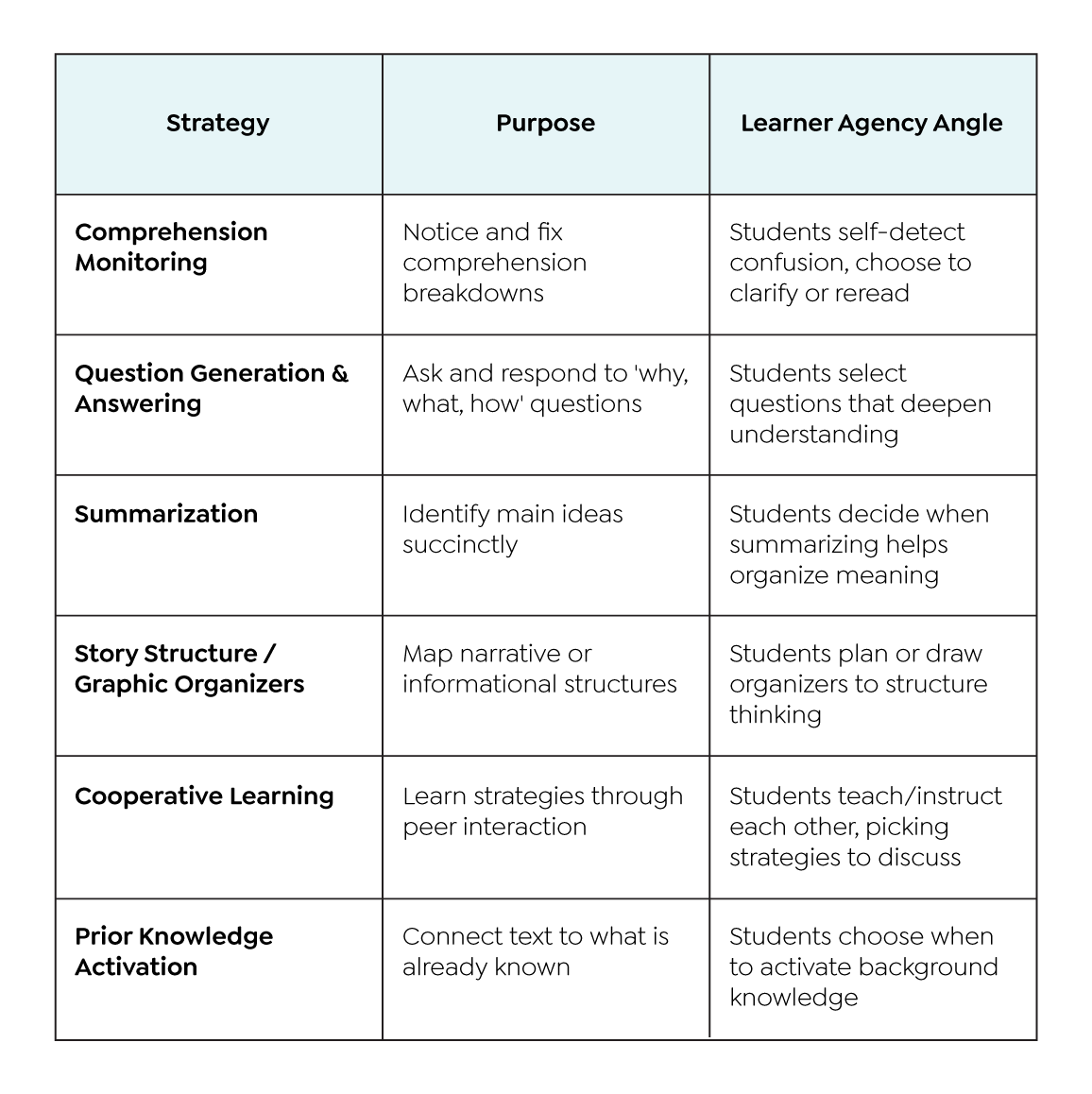 Imagine a classroom buzzing with thoughtful discussions, where students confidently navigate texts, actively choosing strategies that unlock deeper meaning and understanding. At the heart of this thriving learning environment is not just the effective teaching of reading comprehension strategies—but something even more powerful: learner agency.
Imagine a classroom buzzing with thoughtful discussions, where students confidently navigate texts, actively choosing strategies that unlock deeper meaning and understanding. At the heart of this thriving learning environment is not just the effective teaching of reading comprehension strategies—but something even more powerful: learner agency.
Learner agency means students actively take ownership of their learning. They understand their goals, know their strengths and areas for growth, and, most importantly, they can thoughtfully choose the right strategy at the right moment. So how do we cultivate this agency, especially when teaching comprehension? Let’s explore.
Evidence-Based Strategies from the National Reading Panel
The National Reading Panel (2000) identified several research-supported comprehension strategies crucial for strategic reading:

Research emphasizes teaching multiple strategies explicitly through modeling, guided practice, and independent application (National Reading Panel, 2000).
Cultivating Strategic Decision-Making
The true power of learner agency shines when students start making strategic decisions themselves. Encourage students to pause and reflect during reading, asking questions like:
“Which strategy would help me understand this passage better?”
“Should I summarize what I just read or visualize it to grasp the scene?”
“Do I need to clarify confusing vocabulary, or am I ready to infer the author’s meaning?”
By consistently prompting students to make these strategic decisions, they become adept at recognizing when and why certain comprehension strategies are most effective.
Building Background Knowledge and Vocabulary: Keys to Comprehension
Students develop stronger comprehension and increased agency when they connect new texts to their background knowledge. Strategic readers anticipate the need for this connection and proactively draw on previous experiences and learned vocabulary. Teachers facilitate this by explicitly linking new concepts to known information and providing rich, context-based vocabulary instruction.
Approaches for students:
- Preview the text and predict what it might be about based on the title, headings, and images.
- Recall and discuss related personal experiences or previously learned concepts before reading.
- Create visual maps or graphic organizers linking what they know with new ideas presented in the text.
- Use targeted vocabulary words in context during discussions or reflective writing to deepen understanding.
Approaches for teachers:
- Explicitly link new concepts to students’ existing knowledge and experiences through discussions and examples.
- Provide rich, context-based vocabulary instruction using visuals, real-life examples, and connections to familiar situations.
- Facilitate pre-reading activities such as anticipatory guides or K-W-L (Know-Want-Learned) charts.
- Use thematic units or text sets to systematically build and reinforce
Discussion and Collaboration: Reinforcing Agency Through Peer Interaction
Interactive discussions around texts are instrumental in nurturing learner agency. Through structured talk, students articulate their strategy choices, justify decisions, and reflect on outcomes:
“I chose to infer because there were hints about the character’s feelings.”
“Visualizing the scene helped me understand why the event was important.”
Peer conversations reinforce students’ strategic thinking, creating a vibrant community of learners who actively build comprehension together.
Writing as a Tool for Reflection and Agency
Writing is not just a comprehension exercise but a powerful reflection tool. Journaling, summarizing texts, and explaining strategy choices in writing help students internalize comprehension processes. Reflective writing prompts might include:
“Which strategy helped you most today, and why?”
“How did your chosen strategy enhance your understanding?”
“Describe a moment when you realized you needed to change strategies. What did you do and why?”
“If you could teach a classmate one strategy you used today, what would it be and how would you explain it?”
“How did connecting your background knowledge help your comprehension of today’s reading?”
“Write about a strategy you want to improve on next time. What will you do differently?”
“How does writing about your reading help you become a better reader?”
Ongoing Assessment for Responsive Instruction
Frequent formative assessments help students understand their comprehension progress, reinforcing agency as they recognize their growth and identify next steps. Teachers use assessment insights to personalize instruction, continuously guiding students toward more strategic and independent comprehension.
Learner-centered formative assessment examples:
- Students self-assess their comprehension by using strategy checklists and identifying personal successes and challenges.
- Reflective reading journals, where students document their strategy choices and evaluate their effectiveness.
- Quick exit tickets, where students note one comprehension success and one area for growth after each reading.
- Goal-setting conferences, where students set comprehension goals based on formative assessment data and track their progress.
A Classroom Where Learner Agency Thrives
Ultimately, comprehension instruction grounded in learner agency empowers students to achieve their learning goals. They move beyond passive receivers of information to active, strategic readers who understand exactly why, when, and how to use each strategy. The result is not just better comprehension—it’s a lifelong skill set rooted deeply in learner independence and confidence.
In a classroom where learner agency thrives, students don’t just comprehend—they flourish.
Join our Literacy and Justice for All movement here!
References:
- National Reading Panel. (2000). Teaching children to read: An evidence-based assessment of the scientific research literature on reading and its implications for reading instruction. National Institute of Child Health and Human Development. Retrieved from https://www.nichd.nih.gov/sites/default/files/publications/pubs/nrp/documents/report.pdf


